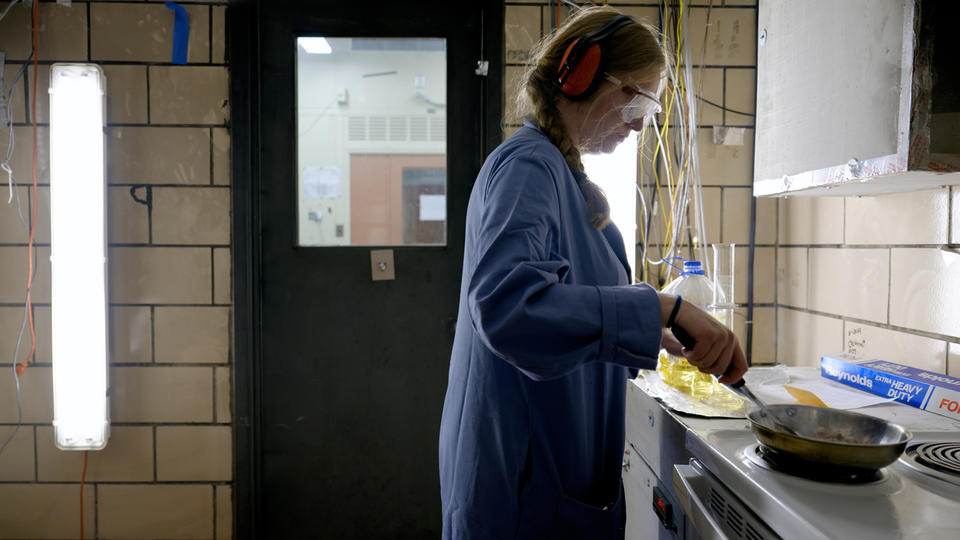
NIST researcher Emma Veley heats up a pan of bacon in the lab to see how long it takes to set off each of the 12 smoke alarms behind her on the ceiling.
R. Eskalis/NIST
Armored with safety glasses, hearing protection, and a fire-retardant lab coat, fire researcher Emma Veley carefully cradled a frying pan of raw bacon into a laboratory surrounded by wires and sensors. Mounted on the ceiling above, 12 smoke detectors waited patiently in a neat row. Veley closed the door behind her, placed the pan on a hot plate, and turned up the heat. Watching her through a large window in the next room, Amy Mensch started a timer and monitored the computer readouts that would show exactly when each alarm would "smell the bacon."
"Modern smoke alarms are really good at detecting fires. However, they have a challenge with not detecting cooking, because cooking is almost a fire," said Mensch, who is the lead author on a new technical report from the National Institute of Standards and Technology (NIST) about how well the latest generation of smoke detectors avoids nuisance alarms. Odds are you've experienced one of these nuisance alarms yourself when cooking or shower steam sets off a smoke alarm. But they're more than just annoying; they can be a real concern for fire safety.
"Studies have found that people who repeatedly have these nuisance alarms tend to disable their devices," explained Mensch, "and when an alarm is disabled, it can't do its main job of alerting people of a real fire."
Raising the Standards for Smoke Alarms
If you examine the back of a smoke alarm, you should see a label saying that it meets UL 217, the manufacturing standard for smoke alarms. This standard is a list of rules to make sure that any smoke alarm performs to a minimum acceptable level. It's maintained by an organization called UL Standards and Engagement with input from a technical panel made up of a wide variety of fire safety experts and from manufacturers and researchers, including some at NIST.
NIST has had a large role in developing and advocating for smoke alarms since the 1970s when the agency funded comprehensive field tests for smoke alarms. Those tests laid the foundation for the first version of the UL 217 standard. Since then, the wide adoption of home smoke alarms is one of the greatest success stories in the history of fire safety. Between 1975 and 2000, the percentage of homes with smoke alarms rose from less than 10% to over 95%. In that same period, the number of deaths from home fires was cut in half. On June 30, 2024, a new standard for smoke alarms, the eighth edition of UL 217, went into effect. For the first time, this standard contains a test for reducing nuisance alarms.
">






